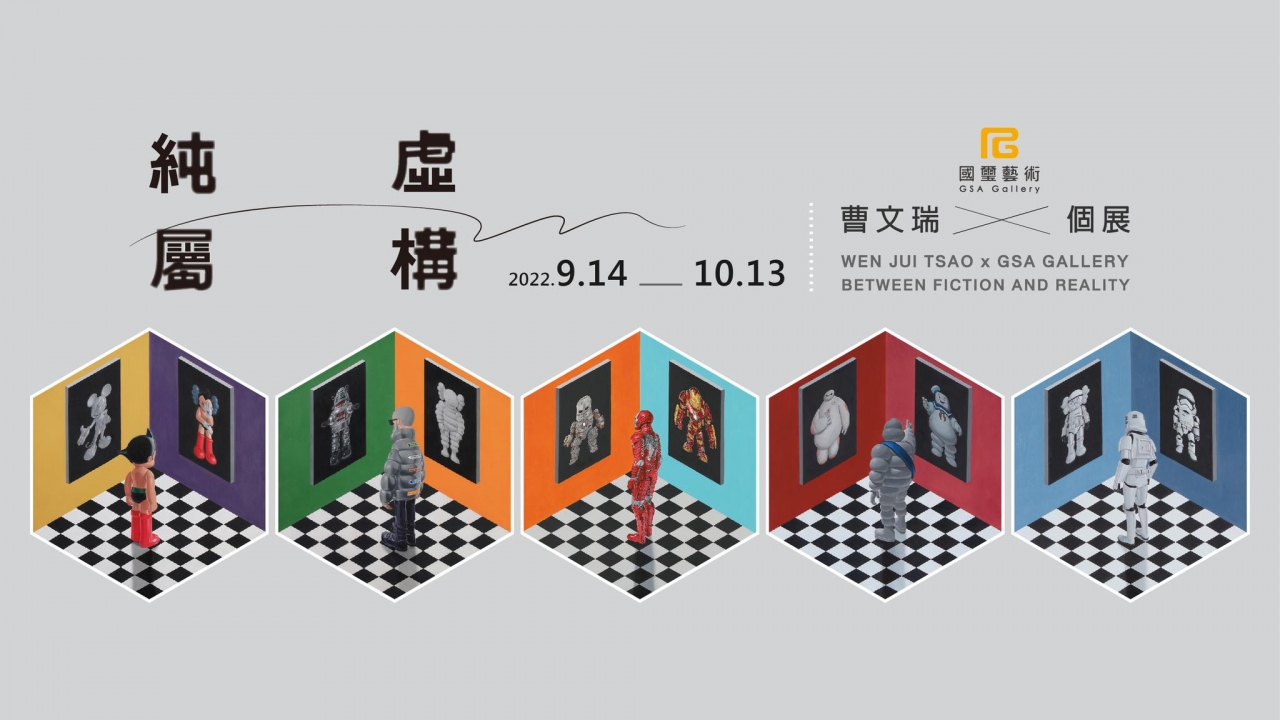
2022 Between Fiction and Reality - Wen Jui TSAO Solo Exhibition 純屬虛構 曹文瑞個展
Sep 14 - Oct 13, 2022
Between Fiction and Reality - Is our world virtual?
Author/Tsao, Wen-Jui
Picasso once said, “I paint objects as I think them, not as I see them.” This famous saying from the history of art has truly inspired the creative aspirations of many younger artists. I can’t help but think of the “Allegory of the Cave” in the opening chapter of The Republic, Book VII, a masterpiece by the ancient Greek philosopher Plato. The content of “Allegory of the Cave” details the process by which the wise men in the fable seek the truth. The article describes a group of people whose freedom of movement has been restricted since their childhood. Even their heads are shackled and they can only look straight ahead at the rock wall of the cave. The world they know and see is from the images projected onto the rock face through the small holes in the wall behind them. These human beings living in an underground cave only know the world through fantasy, illustrating that most people in the world stay in a state of the illusion of consciousness all through their lives.
The exhibition, titled “Between Fiction and Reality” mainly focuses on the appearance of form and content of the works created since my full-time art career began. Looking back on this process, reality and illusion have always been the themes of my creative exploration. The ideas put forward by Picasso and Plato (as mentioned above) seem to work in sync with my creative ideas. “Purely Fictitious” is my present viewpoint on the status quo of the world, stemming from my life experience. Recently, many scientists and scholars have come up with the “The world is virtual” theory, and some evidence has been suggested in support of this theory, including the law of invariability of the speed of light within a vacuum, the extreme idea of programmed operations being regulated in advance, the well-known Mandala Effect, the epitome of organization of human brain cells to nebulae, and the internal structure of atoms in the microscopic world simply appearing as a mini-model of the universe. Although such so-called “evidence” can only be seen as a hypothesis at present, they all provide new insights into the world we know as simulated by higher civilizations.
Leaving the concept of, “The world is virtual” aside, for the time being, the world we live in is indeed rapidly moving in a virtual direction. Whatever virtual currency is issued in the economy, our activities are no longer separate from the internet. Many large enterprises have already established their own Metaverse to create the future life of human beings. In the ongoing Russia-Ukraine war, people in the world have downloaded drone footage through online videos, while the operators who pressed the detonate button on the bombs maybe thousands of miles away. The war scenes on the screen look like virtual scenes in video games and movies, which make people forget for a while that the brutal killing is in progress. The popularization of We-Media has turned many live broadcasters into Internet celebrities. Relying on filters and various face-changing APPs, these live broadcasters have managed to obtain many virtual avatars, thus making it difficult for the audiences to imagine their true appearances. Even in the field of art, NFT creation and trading models have been developing like a raging fire. As for the masses, the transformation of artworks by manipulating pixels displayed on the screen has completely changed the traditional perception of works of art. Artists no longer present genuine works that are completely hand-made, and the only uniqueness in works of art has been transformed into the universally available art that can be owned upon the acquisition of an authentication identification code that symbolizes the ownership of the works of art once online payments are made. I believe that the content and spirit of the works are still the basic elements that determine value no matter how art is presented or traded.
My formative education in art began with oriental ink painting which emphasizes the combination of virtuality and reality. During my study in the United States, I learned sculpture, printmaking, oil painting, pottery, and other creative media in various types of Western art. The idea of leaving a blank area in traditional landscape painting offers an artistic concept in such painted works, which is a world beyond what the eyes can see. The essence of ink painting naturally becomes an energy source and foundation for my creations. After setting foot on the road as a full-time creator in 2009, I finally obtained my long-awaited studio in 2021. Except for going out to buy daily necessities once a week, I lived my creative life like an office worker who punches in at eight o’clock in the morning and out at five o’clock in the evening. In this 13-year artistic journey, I freely developed five series of works based on my ideas. Despite the differences in structure and form, I still basically maintained my initial creative concept of exploring the coexistence of reality and virtuality.
As the first piece of work in the “Mind Window Series”, “Panda’s Journey to the East” started my creative journey. In this work, techniques of appropriation and collage have been applied to shape the scenery as a theater-like set by putting the fictitious scenery in the viewing window. This concept is used to ridicule or satirize the arrogant mentality of human beings who always want to change and confront nature, as I watch the fantasy world of my heart from the perspective of God. The “Virtual Theater Series” that breaks the restriction of the viewing window frame allows the viewing of our world from a wider perspective, which expressed my expectations and viewpoints for this world. Roles, objects, and scenery appearing in the picture are all depicted with focused and delicate brushwork to interpret feelings about the theme of desire. The “Muse Program Series” can be regarded as the sequela of the occupational “disease” I suffered from during my work at the museum. Additionally, the space of museums had great appeal to me. I have turned classic museums around the world into private virtual exhibition venues where exhibits can be replaced, dolls and toys become audiences, and the daily routines of the museums become virtual-reality coexisting scenes. Pop culture now enters the halls of museums to explore the existential value of works of art and historical relics.
When I took the THSR, old photos of the Yuen Shan Amusement Park were provided in a publication for train tourists. This inspired me to develop the “Fantasy Paradise Series”. Paradise has a variety of forms, both real and imaginary. No matter what form it exists in, a paradise can be viewed as a symbol of dreams and happiness as well as the goal of a stage of life. Theme parks are the most realistic virtual worlds in reality. Originally, there were only 2D scenes, but suddenly they turned into a fantasy space that impacted my vision. Being in such a place, it seems that people can temporarily forget the turbulence of the real world. The “Parallel Evolution Series” is an idea derived from the “Muse Program Series”. The mutation shortens the process of species evolution, while the creative ideas make various art forms produce countless invisible connections in the seemingly parallel time and space, like a nuclear explosion after internalization, to begin the transformation and finally evolve into a new creative species.
The COVID-19 epidemic, which broke out in 2020, has spread all over the world and almost no area could escape it by sheer luck. This epidemic has greatly changed human beings’ way of life, and also begun to make them rethink various kinds of influences brought about by science and technology on civilization and natural ecology. The raging epidemic has also brought about significant changes in the development of art, and collectors have turned their eyes to virtual works that can be seen but not touched. In the future, in everything except sleep and diet, human beings’ lives can seemingly be complete in a virtual world. In the real world, with the increasingly rapid development of artificial intelligence and great improvement in the power of computers, scientists estimate that the intelligence owned by a single computer will outperform the total intelligence of all human beings in 2045, and it is likely that the human civilization will reach the so-called “singular point” again. If the capabilities of technology can enhance the civilization constructed by human beings and take it to the next level, it will become a world that most people cannot imagine. If I am still alive by then, I may be able to witness scientists saying that consciousness determines the realm of our existence. As for the forms in which art would exist and develop, it will be truly intriguing and worthy of our expectations.
純屬虛構-我們的世界是虛擬的嗎? 文 / 曹文瑞
畢卡索說:「我並非看著物體在繪畫,而是按著自己的思想在繪畫。」這句藝術史上的千古名言,著實啟發了許多後輩藝術家的創作靈感。我不禁聯想到古希臘哲學家柏拉圖的著作《理想國》對話集第七卷開篇中的「洞穴預言」;內容詳述好智者尋求真知的過程。文中描述一群從小即被限制行動自由的人,連頭部都上枷鎖只能直直望著洞穴岩壁,他們所知所見的世界都是從身後壁面上的小孔洞所投射到岩壁上的影像。這些穴居的人對世界的認知全部來自於幻影,指涉世界上大多數人的一生都停留在幻象的知覺狀態。
關於「純屬虛構」的展覽命題,主要是針對從專職創作以來作品的形式與內容所呈現的一種面貌。回顧這段歷程,真實與假象一直是我在創作上探討的主題,上述文中的畢卡索與柏拉圖提出的想法,似乎能適切地呼應我的創作理念。「純屬虛構」是當下我對世界現狀的看法,也是來自於生活的體驗。近期不少科學家與學者提出「世界是虛擬的」之理論,其中也舉出一些證據來支持;包括光速在真空中的速度永恆不變的定律如同程式運作的極限被事先規範了一般、知名的曼德拉效應、人類的腦細胞組織與星雲極為相似、微觀世界中原子的內部結構簡直就是宇宙的迷你模型。這些所謂的證據目前雖然只能稱得上是假說,不過都是為我們所認知的世界是由更高等文明所模擬出來的提出了嶄新的見解。
暫時撇開「世界是虛擬的」之說法,我們所處的世界目前確實正往虛擬的方向快速發展下去,無論是經濟活動上發行的虛擬貨幣,或是生活上與網路早已密不可分,許多大企業已建立起自己的元宇宙構築未來人類的生活樣貌。目前仍在持續進行中的俄烏戰爭,全世界透過網路視頻下載了無人機鏡頭下的一切,而按下投彈按鍵的操控者可能遠在千里之外,螢幕中戰爭場面像是電玩與電影中虛擬的場景,讓人一時間忘了殘酷的殺戮此時正在進行。方興未艾的自媒體潮流讓許多直播主成為網路紅人。使用濾鏡與各種變臉APP的幫襯之下,直播主擁有許多虛擬分身,讓觀眾難以想像本尊的真實樣貌。甚至是藝術也開始在如火如荼的進行NFT的創作與交易模式。對社會大眾而言能夠觸摸的作品轉換成在螢幕上呈現的畫素,已完全顛覆了傳統對於藝術品的認知,藝術家不再提出完全手作的真跡,藝術品是唯一的稀有性,轉變成在線上付費後取得象徵所有權認證識別碼即能擁有的普遍性。我覺得不論藝術的呈現與交易方式如何改變,內容與作品精神仍是決定價值的基本要素。
我的藝術養成教育始於著重虛實相生的東方水墨,在美國留學期間則學習了西方藝術類型中的雕塑、版畫、油畫、陶藝……等創作媒材。傳統山水畫對於留白的概念讓畫作呈現出了意境,那是超越眼睛所能觀看的世界。水墨藝術的精髓很自然的成為我創作的養分來源。從2009年踏上專職創作之路後直到2021年終於有了期盼已久的專用工作室,除了每周一次外出採買生活用品之外,其他時間就彷彿是上班族一般過著朝八晚五的創作生活。這段長達十三年的藝術旅程,隨著意念自由發展了五個系列作品。雖然架構與形式互異基本上仍維持著探索真實與虛擬並存的創作理念。
「胖達的東方之旅」開啟了我的創作旅程,這件「心靈視窗系列」的首件作品以挪用及拼貼的手法將虛構的風景與虛擬的角色透過觀景窗,將景色塑造成類似劇場的佈景一般,以此概念揶揄、反諷人類一直想要改變自然與大自然對抗的自大心態,用上帝的視角觀看我心中幻想的世界。打破觀景窗框架限制的「虛擬劇場系列」以更開闊的視野去觀看我們的世界,表達我對這個世界的期盼與看法。畫面中出現的角色、物件、風景都以聚焦的細膩筆法去描繪,藉以詮釋慾望這個主題的感想。「謬思計畫系列」可以看作是我曾經任職博物館,得了職業病的後遺症。博物館的空間對我而言有著莫大的吸引力,我將世界各地的經典博物館變成私人的虛擬展場,置換展品,公仔與玩具成為觀眾,博物館之日常成為虛實並存的景象。流行文化進入博物館殿堂,用以探討藝術品與歷史文物的存在價值。
在一次搭乘高鐵時,車上刊物中的圓山兒童樂園的老照片給了我發展「幻想樂園系列」的靈感,樂園有各種形態,有真實的有想像的,無論存在的形態為何?都可看作是夢想與歡樂的象徵,也是一種人生舞台的縮影。主題樂園是現實世界中最為擬真的虛擬世界,原本只存在 2D中的場景,搖身一變成為衝擊視覺的奇幻空間,身處其中似乎能讓人暫時忘了紛紛擾擾的現實世界。「平行演化系列」是從「謬思計畫系列」衍生而來的想法,突變縮短了物種演化的進程,創意發想則是讓各種藝術形式在看似平行的時空中產生無數看不見的隱形連結,像是進行一種內化後的核爆,開始產生變形,最後演化成新的藝術物種!
2020年開始爆發流行的COVID-19疫情影響遍及全球幾乎沒有一塊土地倖免,大大改變了人類的生活模式,也開始讓人類再次認真思考科技帶給文明與自然生態的各種影響。疫情肆虐也讓藝術的發展起了不小的變化,藏家的目光也開始轉向看得到、摸不著的虛擬作品。在未來人類的日常生活除了睡眠與飲食之外似乎都能在虛擬世界完成。在人工智能日益快速發展的現實世界中,隨著電腦的運算能力大幅提升之後,科學家估計在2045年一台電腦擁有的智能將會超過全人類的智慧總和,人類的文明可能再次來到所謂的「奇異點」。科技的能力若能將人類建構的文明提升至更高的維度,那將會是大多數人無法想像的世界。屆時如果我仍然健在的話,或許能見證科學家所說的意識決定了我們的存在之境界!至於藝術將會以何種形式存在與發展著實令人好奇與期待。
Author/Tsao, Wen-Jui
Picasso once said, “I paint objects as I think them, not as I see them.” This famous saying from the history of art has truly inspired the creative aspirations of many younger artists. I can’t help but think of the “Allegory of the Cave” in the opening chapter of The Republic, Book VII, a masterpiece by the ancient Greek philosopher Plato. The content of “Allegory of the Cave” details the process by which the wise men in the fable seek the truth. The article describes a group of people whose freedom of movement has been restricted since their childhood. Even their heads are shackled and they can only look straight ahead at the rock wall of the cave. The world they know and see is from the images projected onto the rock face through the small holes in the wall behind them. These human beings living in an underground cave only know the world through fantasy, illustrating that most people in the world stay in a state of the illusion of consciousness all through their lives.
The exhibition, titled “Between Fiction and Reality” mainly focuses on the appearance of form and content of the works created since my full-time art career began. Looking back on this process, reality and illusion have always been the themes of my creative exploration. The ideas put forward by Picasso and Plato (as mentioned above) seem to work in sync with my creative ideas. “Purely Fictitious” is my present viewpoint on the status quo of the world, stemming from my life experience. Recently, many scientists and scholars have come up with the “The world is virtual” theory, and some evidence has been suggested in support of this theory, including the law of invariability of the speed of light within a vacuum, the extreme idea of programmed operations being regulated in advance, the well-known Mandala Effect, the epitome of organization of human brain cells to nebulae, and the internal structure of atoms in the microscopic world simply appearing as a mini-model of the universe. Although such so-called “evidence” can only be seen as a hypothesis at present, they all provide new insights into the world we know as simulated by higher civilizations.
Leaving the concept of, “The world is virtual” aside, for the time being, the world we live in is indeed rapidly moving in a virtual direction. Whatever virtual currency is issued in the economy, our activities are no longer separate from the internet. Many large enterprises have already established their own Metaverse to create the future life of human beings. In the ongoing Russia-Ukraine war, people in the world have downloaded drone footage through online videos, while the operators who pressed the detonate button on the bombs maybe thousands of miles away. The war scenes on the screen look like virtual scenes in video games and movies, which make people forget for a while that the brutal killing is in progress. The popularization of We-Media has turned many live broadcasters into Internet celebrities. Relying on filters and various face-changing APPs, these live broadcasters have managed to obtain many virtual avatars, thus making it difficult for the audiences to imagine their true appearances. Even in the field of art, NFT creation and trading models have been developing like a raging fire. As for the masses, the transformation of artworks by manipulating pixels displayed on the screen has completely changed the traditional perception of works of art. Artists no longer present genuine works that are completely hand-made, and the only uniqueness in works of art has been transformed into the universally available art that can be owned upon the acquisition of an authentication identification code that symbolizes the ownership of the works of art once online payments are made. I believe that the content and spirit of the works are still the basic elements that determine value no matter how art is presented or traded.
My formative education in art began with oriental ink painting which emphasizes the combination of virtuality and reality. During my study in the United States, I learned sculpture, printmaking, oil painting, pottery, and other creative media in various types of Western art. The idea of leaving a blank area in traditional landscape painting offers an artistic concept in such painted works, which is a world beyond what the eyes can see. The essence of ink painting naturally becomes an energy source and foundation for my creations. After setting foot on the road as a full-time creator in 2009, I finally obtained my long-awaited studio in 2021. Except for going out to buy daily necessities once a week, I lived my creative life like an office worker who punches in at eight o’clock in the morning and out at five o’clock in the evening. In this 13-year artistic journey, I freely developed five series of works based on my ideas. Despite the differences in structure and form, I still basically maintained my initial creative concept of exploring the coexistence of reality and virtuality.
As the first piece of work in the “Mind Window Series”, “Panda’s Journey to the East” started my creative journey. In this work, techniques of appropriation and collage have been applied to shape the scenery as a theater-like set by putting the fictitious scenery in the viewing window. This concept is used to ridicule or satirize the arrogant mentality of human beings who always want to change and confront nature, as I watch the fantasy world of my heart from the perspective of God. The “Virtual Theater Series” that breaks the restriction of the viewing window frame allows the viewing of our world from a wider perspective, which expressed my expectations and viewpoints for this world. Roles, objects, and scenery appearing in the picture are all depicted with focused and delicate brushwork to interpret feelings about the theme of desire. The “Muse Program Series” can be regarded as the sequela of the occupational “disease” I suffered from during my work at the museum. Additionally, the space of museums had great appeal to me. I have turned classic museums around the world into private virtual exhibition venues where exhibits can be replaced, dolls and toys become audiences, and the daily routines of the museums become virtual-reality coexisting scenes. Pop culture now enters the halls of museums to explore the existential value of works of art and historical relics.
When I took the THSR, old photos of the Yuen Shan Amusement Park were provided in a publication for train tourists. This inspired me to develop the “Fantasy Paradise Series”. Paradise has a variety of forms, both real and imaginary. No matter what form it exists in, a paradise can be viewed as a symbol of dreams and happiness as well as the goal of a stage of life. Theme parks are the most realistic virtual worlds in reality. Originally, there were only 2D scenes, but suddenly they turned into a fantasy space that impacted my vision. Being in such a place, it seems that people can temporarily forget the turbulence of the real world. The “Parallel Evolution Series” is an idea derived from the “Muse Program Series”. The mutation shortens the process of species evolution, while the creative ideas make various art forms produce countless invisible connections in the seemingly parallel time and space, like a nuclear explosion after internalization, to begin the transformation and finally evolve into a new creative species.
The COVID-19 epidemic, which broke out in 2020, has spread all over the world and almost no area could escape it by sheer luck. This epidemic has greatly changed human beings’ way of life, and also begun to make them rethink various kinds of influences brought about by science and technology on civilization and natural ecology. The raging epidemic has also brought about significant changes in the development of art, and collectors have turned their eyes to virtual works that can be seen but not touched. In the future, in everything except sleep and diet, human beings’ lives can seemingly be complete in a virtual world. In the real world, with the increasingly rapid development of artificial intelligence and great improvement in the power of computers, scientists estimate that the intelligence owned by a single computer will outperform the total intelligence of all human beings in 2045, and it is likely that the human civilization will reach the so-called “singular point” again. If the capabilities of technology can enhance the civilization constructed by human beings and take it to the next level, it will become a world that most people cannot imagine. If I am still alive by then, I may be able to witness scientists saying that consciousness determines the realm of our existence. As for the forms in which art would exist and develop, it will be truly intriguing and worthy of our expectations.
純屬虛構-我們的世界是虛擬的嗎? 文 / 曹文瑞
畢卡索說:「我並非看著物體在繪畫,而是按著自己的思想在繪畫。」這句藝術史上的千古名言,著實啟發了許多後輩藝術家的創作靈感。我不禁聯想到古希臘哲學家柏拉圖的著作《理想國》對話集第七卷開篇中的「洞穴預言」;內容詳述好智者尋求真知的過程。文中描述一群從小即被限制行動自由的人,連頭部都上枷鎖只能直直望著洞穴岩壁,他們所知所見的世界都是從身後壁面上的小孔洞所投射到岩壁上的影像。這些穴居的人對世界的認知全部來自於幻影,指涉世界上大多數人的一生都停留在幻象的知覺狀態。
關於「純屬虛構」的展覽命題,主要是針對從專職創作以來作品的形式與內容所呈現的一種面貌。回顧這段歷程,真實與假象一直是我在創作上探討的主題,上述文中的畢卡索與柏拉圖提出的想法,似乎能適切地呼應我的創作理念。「純屬虛構」是當下我對世界現狀的看法,也是來自於生活的體驗。近期不少科學家與學者提出「世界是虛擬的」之理論,其中也舉出一些證據來支持;包括光速在真空中的速度永恆不變的定律如同程式運作的極限被事先規範了一般、知名的曼德拉效應、人類的腦細胞組織與星雲極為相似、微觀世界中原子的內部結構簡直就是宇宙的迷你模型。這些所謂的證據目前雖然只能稱得上是假說,不過都是為我們所認知的世界是由更高等文明所模擬出來的提出了嶄新的見解。
暫時撇開「世界是虛擬的」之說法,我們所處的世界目前確實正往虛擬的方向快速發展下去,無論是經濟活動上發行的虛擬貨幣,或是生活上與網路早已密不可分,許多大企業已建立起自己的元宇宙構築未來人類的生活樣貌。目前仍在持續進行中的俄烏戰爭,全世界透過網路視頻下載了無人機鏡頭下的一切,而按下投彈按鍵的操控者可能遠在千里之外,螢幕中戰爭場面像是電玩與電影中虛擬的場景,讓人一時間忘了殘酷的殺戮此時正在進行。方興未艾的自媒體潮流讓許多直播主成為網路紅人。使用濾鏡與各種變臉APP的幫襯之下,直播主擁有許多虛擬分身,讓觀眾難以想像本尊的真實樣貌。甚至是藝術也開始在如火如荼的進行NFT的創作與交易模式。對社會大眾而言能夠觸摸的作品轉換成在螢幕上呈現的畫素,已完全顛覆了傳統對於藝術品的認知,藝術家不再提出完全手作的真跡,藝術品是唯一的稀有性,轉變成在線上付費後取得象徵所有權認證識別碼即能擁有的普遍性。我覺得不論藝術的呈現與交易方式如何改變,內容與作品精神仍是決定價值的基本要素。
我的藝術養成教育始於著重虛實相生的東方水墨,在美國留學期間則學習了西方藝術類型中的雕塑、版畫、油畫、陶藝……等創作媒材。傳統山水畫對於留白的概念讓畫作呈現出了意境,那是超越眼睛所能觀看的世界。水墨藝術的精髓很自然的成為我創作的養分來源。從2009年踏上專職創作之路後直到2021年終於有了期盼已久的專用工作室,除了每周一次外出採買生活用品之外,其他時間就彷彿是上班族一般過著朝八晚五的創作生活。這段長達十三年的藝術旅程,隨著意念自由發展了五個系列作品。雖然架構與形式互異基本上仍維持著探索真實與虛擬並存的創作理念。
「胖達的東方之旅」開啟了我的創作旅程,這件「心靈視窗系列」的首件作品以挪用及拼貼的手法將虛構的風景與虛擬的角色透過觀景窗,將景色塑造成類似劇場的佈景一般,以此概念揶揄、反諷人類一直想要改變自然與大自然對抗的自大心態,用上帝的視角觀看我心中幻想的世界。打破觀景窗框架限制的「虛擬劇場系列」以更開闊的視野去觀看我們的世界,表達我對這個世界的期盼與看法。畫面中出現的角色、物件、風景都以聚焦的細膩筆法去描繪,藉以詮釋慾望這個主題的感想。「謬思計畫系列」可以看作是我曾經任職博物館,得了職業病的後遺症。博物館的空間對我而言有著莫大的吸引力,我將世界各地的經典博物館變成私人的虛擬展場,置換展品,公仔與玩具成為觀眾,博物館之日常成為虛實並存的景象。流行文化進入博物館殿堂,用以探討藝術品與歷史文物的存在價值。
在一次搭乘高鐵時,車上刊物中的圓山兒童樂園的老照片給了我發展「幻想樂園系列」的靈感,樂園有各種形態,有真實的有想像的,無論存在的形態為何?都可看作是夢想與歡樂的象徵,也是一種人生舞台的縮影。主題樂園是現實世界中最為擬真的虛擬世界,原本只存在 2D中的場景,搖身一變成為衝擊視覺的奇幻空間,身處其中似乎能讓人暫時忘了紛紛擾擾的現實世界。「平行演化系列」是從「謬思計畫系列」衍生而來的想法,突變縮短了物種演化的進程,創意發想則是讓各種藝術形式在看似平行的時空中產生無數看不見的隱形連結,像是進行一種內化後的核爆,開始產生變形,最後演化成新的藝術物種!
2020年開始爆發流行的COVID-19疫情影響遍及全球幾乎沒有一塊土地倖免,大大改變了人類的生活模式,也開始讓人類再次認真思考科技帶給文明與自然生態的各種影響。疫情肆虐也讓藝術的發展起了不小的變化,藏家的目光也開始轉向看得到、摸不著的虛擬作品。在未來人類的日常生活除了睡眠與飲食之外似乎都能在虛擬世界完成。在人工智能日益快速發展的現實世界中,隨著電腦的運算能力大幅提升之後,科學家估計在2045年一台電腦擁有的智能將會超過全人類的智慧總和,人類的文明可能再次來到所謂的「奇異點」。科技的能力若能將人類建構的文明提升至更高的維度,那將會是大多數人無法想像的世界。屆時如果我仍然健在的話,或許能見證科學家所說的意識決定了我們的存在之境界!至於藝術將會以何種形式存在與發展著實令人好奇與期待。

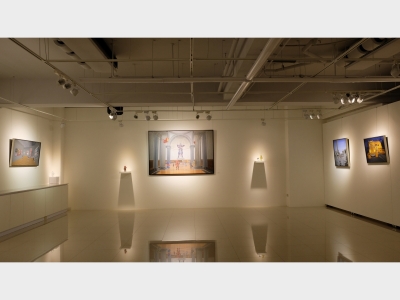
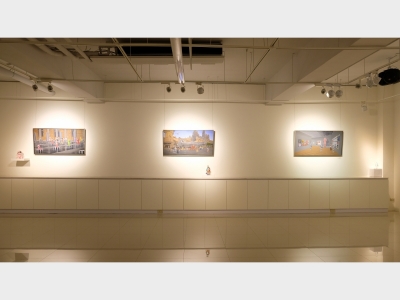
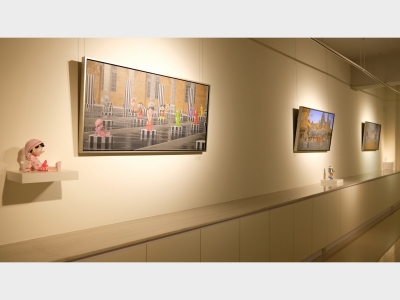
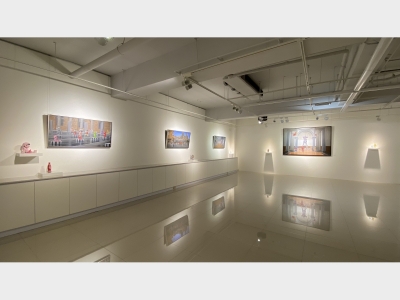

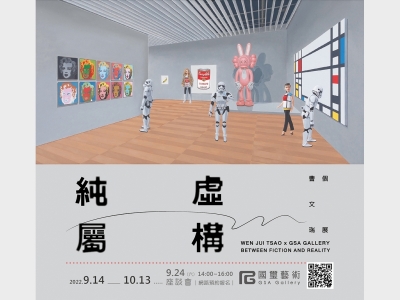

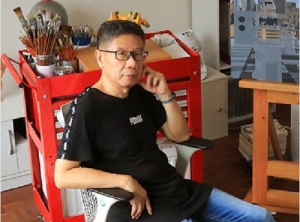 Wen Jui TSAO 曹文瑞
Wen Jui TSAO 曹文瑞